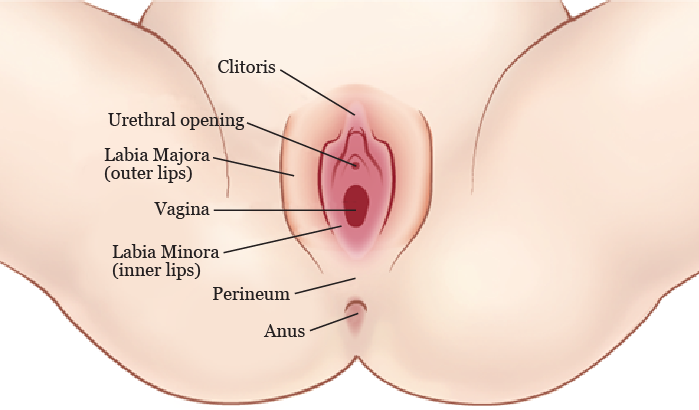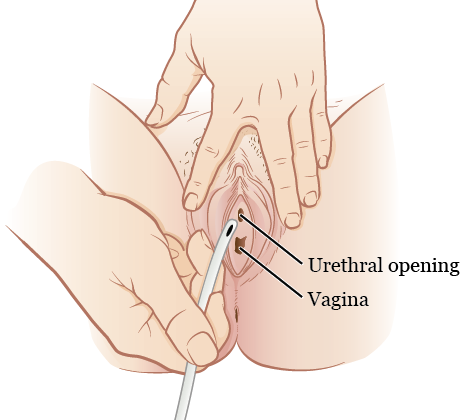This information explains how to insert your catheter to drain your urine (pee).
A catheter is a flexible tube that drains urine from your bladder. You’ll insert your catheter yourself by placing it into your urethra (the small tube that carries urine from your bladder to outside your body) through your urethral opening above your vagina (see Figure 1). Your catheter will drain your urine.
About your vulva
Vulva is another name for your external sex organs or genitals (see Figure 1). Your vulva includes:

- The inner and outer lips of your labia.
- Your clitoris.
- The opening of your vagina.
- Your vaginal glands, which are in the area between your vulva and anus (the perineum).
- Your urethral opening. This is the opening to your urethra (the tube that carries urine outside of your body).
How to self-catheterize
Most people insert their catheters in the bathroom, letting the urine drain into the toilet. You’ll get a container to collect your urine in case you need to insert your catheter somewhere else.
Follow these instructions to help you insert your catheter:
-
Clean your hands.
- If you’re washing your hands with soap and water, wet your hands, apply soap, rub them together thoroughly for at least 20 seconds, then rinse. Dry your hands with a disposable towel, and use that same towel to turn off the faucet.
- If you’re using an alcohol-based hand sanitizer, cover all of your hands with it, rubbing them together until they’re dry.
-
Gather your supplies on a clean surface. You’ll need:
- Your catheter
- A water-based lubricant (such as K-Y Jelly®)
- Paper towels
- A mirror to help guide you
- A container to collect your urine in if you’re not able to catheterize in a bathroom.
- Clean your vulva with soap and water. Make sure to dry the area before catheterizing.
-
Stand in front of or sit on a toilet. You can also insert your catheter in a private room using a container to collect your urine.
- It may be helpful to use a mirror so that you can see your vulva. You may need someone else to hold the mirror for you.
- If you stand, spread your legs or use a chair or the toilet to raise 1 leg.
- If you sit, raise 1 leg or sit in a frog position. To use the frog position, bend your knees, place your feet together, and spread your knees apart. It’s helpful to have a table or chair in front of the toilet to rest your feet on.
- Now you’ll insert the catheter into your urethra. Find your urethral opening just above your vagina and below your clitoris (see Figure 1).
- Lubricate the catheter and hold it in your dominant hand (the hand you write with).
- Spread your labia with your other hand and pull upward.
-
Insert the lubricated catheter into your urethra (see Figure 2). Make sure not to place the catheter into your vagina.
- You can put a tissue, tampon, or a finger on your non-dominant hand into your vagina. This will prevent you from putting the catheter into your vagina.
-
You can also place a mirror in front of you so you can see your urethra and vagina.

Figure 2. Inserting the catheter
- Push the catheter in until urine begins to drain. Hold the catheter in place until no more urine is draining.
- When the draining has stopped, slowly pull the catheter out. If you have used a tampon or tissue, remove it.
- You should use a new catheter each time you self-catheterize. If you have to use the same one, make sure to clean it with soap and water. Let it air dry on a clean surface. Once it’s dry, store the catheter in a clean place covered with a paper towel or in a zip lock bag.
- Clean your hands following the instructions in step 1.
Remember to always carry an extra catheter with you in case of an emergency.
After your self-catheterization
- Your urethra may feel irritated after you catheterize. This is normal.
-
You may have some bleeding during or after your catheterization.
- Your urine may turn light orange due to this blood, so drink some water. This will flush your bladder.
- You should use a new catheter each time you self-catheterize. Your nurse will let you know how to get new catheters for your next catheterization. If you have to, you can reuse the same catheter but it’s better to use a new one.
When to call your healthcare provider
Call your healthcare provider if you have:
- A fever of 101 °F (38.3 °C) or higher.
- Chills.
- Pelvic pain.
- Pain on the sides of your body by your ribs.
- Trouble inserting or removing the catheter.
- Nausea (feeling like you’re going to throw up).
- Vomiting (throwing up).
- Any questions or concerns.